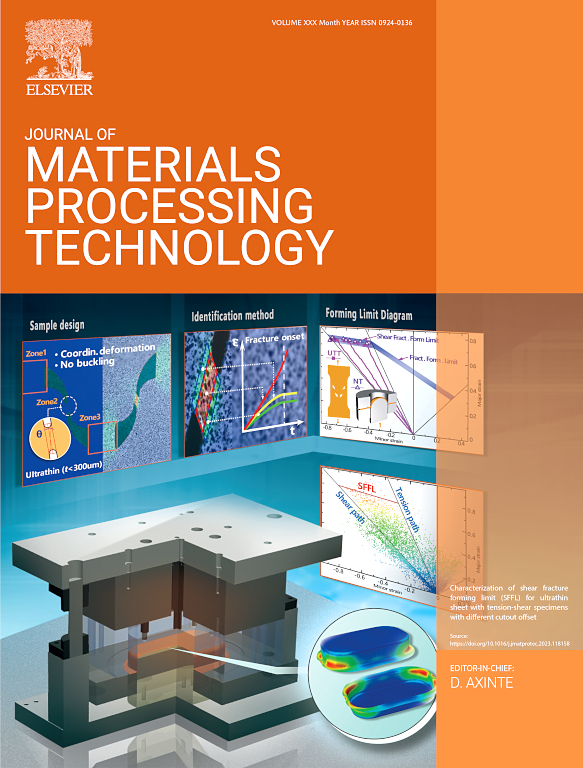Process gas-assisted surface modifications on Zn-Mg-Al alloy-coatings using atmospheric pressure plasma for improved adhesion to structural adhesives
IF 7.5
2区 材料科学
Q1 ENGINEERING, INDUSTRIAL
Journal of Materials Processing Technology
Pub Date : 2025-06-27
DOI:10.1016/j.jmatprotec.2025.118950
引用次数: 0
Abstract
Adhesion between Zn-Mg-Al (ZMA) alloy-coated steel sheets and epoxy is critical for automotive applications, yet surface oxides often hinder bonding efficacy. This study systematically investigates atmospheric pressure plasma treatment (APPT) using argon, oxygen, nitrogen, and compressed air as process gases to enhance the bonding between ZMA coatings and epoxy adhesives. APPT operates under ambient conditions, eliminating the need for vacuum chambers and enabling scalable integration into industrial workflows. The nozzle-based plasma system allows uniform treatment of large steel sheets, making it suitable for roll-to-roll processing in high-throughput production lines. Electron microscopic analysis revealed that the composition of process gases significantly influences surface modifications. Surface characterization techniques confirmed the ability of air plasma to reduce carbon contamination and enhance adhesion strength compared to untreated ZMA coatings. Air plasma uniquely generates hydroxyl-rich compounds, such as Mg(OH)2, AlO(OH), and Zn5(CO3)2(OH)6, which increase surface polarity and wettability while creating nano-roughened spherical morphologies conducive to mechanical interlocking. Single-lap shear tests demonstrated that air-plasma-treated samples exhibited superior adhesion strength, achieving 701 MPa, which was more than twice that of untreated samples. Cohesive zone modeling simulations validated these findings by demonstrating uniform stress distribution at the coating-substrate interface, minimizing delamination risks under mechanical loading. By addressing critical challenges in adhesion reliability, scalability, and cost-effectiveness, this study establishes APPT as a transformative solution for advancing high-performance ZMA coatings in automotive applications while meeting the demands of modern manufacturing processes.
利用常压等离子体对Zn-Mg-Al合金涂层进行气体辅助表面改性,以提高其与结构粘合剂的附着力
锌镁铝(ZMA)合金涂层钢板与环氧树脂之间的粘合对于汽车应用至关重要,但表面氧化物通常会阻碍粘合效果。本研究系统地研究了常压等离子体处理(APPT),使用氩气、氧气、氮气和压缩空气作为工艺气体来增强ZMA涂层与环氧胶粘剂之间的结合。APPT在环境条件下运行,无需真空室,并可扩展集成到工业工作流程中。基于喷嘴的等离子体系统允许对大型钢板进行均匀处理,使其适用于高吞吐量生产线的卷对卷加工。电镜分析表明,工艺气体的组成对表面改性有显著影响。表面表征技术证实,与未经处理的ZMA涂层相比,空气等离子体能够减少碳污染,提高附着力。空气等离子体独特地产生富含羟基的化合物,如Mg(OH)2、AlO(OH)和Zn5(CO3)2(OH)6,这些化合物增加了表面极性和润湿性,同时产生有利于机械联锁的纳米粗糙球形形貌。单搭接剪切试验表明,空气等离子体处理的样品具有较好的粘附强度,达到701 MPa,是未处理样品的两倍以上。内聚区建模模拟通过展示涂层-衬底界面的均匀应力分布来验证这些发现,从而最大限度地减少了机械载荷下的分层风险。通过解决粘合可靠性、可扩展性和成本效益方面的关键挑战,该研究将APPT确立为一种变革性的解决方案,在满足现代制造工艺要求的同时,推进高性能ZMA涂料在汽车应用中的应用。
本文章由计算机程序翻译,如有差异,请以英文原文为准。
求助全文
约1分钟内获得全文
求助全文
来源期刊

Journal of Materials Processing Technology
工程技术-材料科学:综合
CiteScore
12.60
自引率
4.80%
发文量
403
审稿时长
29 days
期刊介绍:
The Journal of Materials Processing Technology covers the processing techniques used in manufacturing components from metals and other materials. The journal aims to publish full research papers of original, significant and rigorous work and so to contribute to increased production efficiency and improved component performance.
Areas of interest to the journal include:
• Casting, forming and machining
• Additive processing and joining technologies
• The evolution of material properties under the specific conditions met in manufacturing processes
• Surface engineering when it relates specifically to a manufacturing process
• Design and behavior of equipment and tools.
 求助内容:
求助内容: 应助结果提醒方式:
应助结果提醒方式:


